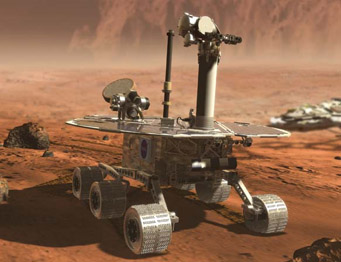This month marks the sixth anniversary of the 2004 arrival on Mars of the NASA rovers Spirit (January 4th) and Opportunity (January 25th). As I noted in December, things have not gone well for Spirit since its wheels became mired in soft sand last May.

NASA's twin Martian rovers were designed to trek up to 100 meters per day. After six years of operation, Opportunity is still moving well across the landscape, but Spirit appears to be hopelessly stuck in a sand drift.
NASA / JPL
Unfortunately, the past month's all-out effort to free the craft has resulted in lots of frustration but little movement. It didn't help that a second wheel failed on the right side. And the situation is getting more dire because Martian winter is approaching, which means the Sun is providing less energy each sol (day) for electricity and it's getting colder.
Today, NASA managers held a press briefing to announce that they've called off the effort to get Spirit rolling again. Instead, operations in the coming weeks will focus on improving the craft's tilt so its solar-cell panels can receive more sunlight during the winter months ahead. The craft is designed to withstand temperatures down to –67°F (–55°C), and scientists expect it to survive the coming cold provided there's enough electricity to power critical internal heaters.
If Spirit really has reached its final destination, then let the record show that it traveled a remarkable 4.80 miles (7.73 km) since thumping onto the flat floor of Gusev crater. But immobility doesn't mean that the mission is over. Instead, the team wants to take advantage of being motionless to conduct an interesting new kind of science.
As explained today by Steve Squyres, the Cornell researcher who serves as the mission's principal investigator, Spirit will become a radio beacon for tracking the rover's exact location as Mars rotates. If Spirit can continue transmitting for several more months, engineers will be able to determine its position on the surface to within a few inches and track tiny wobbles in the rotation of Mars. These measurements, in turn, should reveal whether the Red Planet is solid throughout or has a liquid outer core.
This kind of "stationary science" was performed during the Mars Pathfinder mission during the late 1990s. Although the results were useful, Pathfinder didn't operate on Mars long enough to get the desired precision. Back in the late 1970s, two Viking landers stayed put during several years of operation, but they utilized older radio technology that couldn't make the needed measurements either.
"If the final scientific feather in Spirit's cap is determining whether the core of Mars is liquid or solid, that would be wonderful," Squyres commented today. "It's so different from the other knowledge we've gained."
 0
0
Comments
You must be logged in to post a comment.